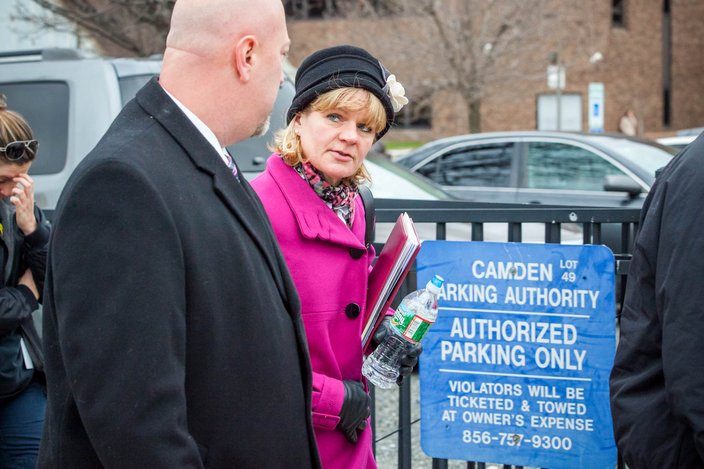
January 14, 2016
Brendan Link Creato died from “homicidal violence of undetermined etiology,” according to the Camden County Prosecutor’s Office.
That’s a problematic call, both medically and legally, a professor of forensic pathology and several defense lawyers told PhillyVoice.
“It is a diagnosis that is trying to say something, but is saying nothing,” said Dr. Zhongxue Hua, a former New Jersey medical examiner who is now a professor and consultant in New York.
The diagnosis “really means there is not enough to make this call,” Hua added.
Christine Shah, who oversees homicide investigations for the prosecutor’s office, disclosed the inexact determination on the boy’s cause of death – made Dec. 15 – for the first time during Tuesday's arraignment of the toddler's father, David "DJ" Creato Jr., 22, on first-degree murder charges.
Shah said the precise cause of death could be one of three things: Drowning, asphyxiation or smothering.
Accoridng to Hua, those causes of death are distinct, with clear physical markers. The only characteristic they share is a lack of oxygen, he said. That imprecision could prove problematic for prosecutors, he said.
Brendan Creato’s body was discovered Oct. 13 in a park he and his father had visited often about a half a mile from their home in the Westmont section of Haddon Township.
The toddler had been in the care of his father, who called 911 around 6 a.m. on Oct. 13 to report his son was missing. The boy’s body was found three hours later.
Shah explained in court the diagnosis was based on the findings of two of three pathologists who had examined the boy’s body two months earlier.
One pathologist, Dr. Gerald “Buck” Feigin, Camden County’s medical examiner, found a small area of the boy’s brain indicated a lack of oxygen during the initial, Oct. 14 autopsy.
A second examination by a private-practice pathologist, Dr. Charles Siebert, discovered a fresh bruise on the boy's collarbone – a bruise so small it was overlooked by Feigin.
A third pathologist, the state’s acting medical examiner, Dr. Anthony Falzon, found nothing additional during a third examination.
Toxicology and microscopic reports yielded no new information.
There are apparently no witnesses, and no admissions of guilt, despite hours of interviewing DJ Creato on Oct. 13 and the close examinations of nearly 9,500 texts and numerous social media postings between Creato and his 17-year-old girlfriend, Julia “Julie” Spensky of Bucks County.
Shah alleged DJ Creato's motive for killing his son was to hold onto his rocky relationship with Spensky, now a college student in New York, who did not like children.
The absence of witnesses and confessions leaves the call on the cause of death based solely on the scant findings of the two doctors.
A spokesman for the Camden County Prosecutor’s Office did not respond to a request for comment on the finding.
The circumstantial evidence and the indefinite finding makes the state’s case against DJ Creato ripe to be picked apart, according to Hua and two defense lawyers with no connection to the case. So do the backgrounds of both Feigin and Siebert.
Feigin’s career as a medical examiner in Massachusetts unraveled after making a bad call as to the cause of death in the so-called “Boston Nanny” case. Feigin’s office has previously referred requests for comment to the prosecutor’s office, which has never addressed his experience.
Likewise, Siebert’s career as a medical examiner in Florida derailed after his involvement in the autopsy of a juvenile who died at a boot camp prison for young offenders. The Florida boot camp system closed after the death. Now a private practice pathologist in Atlantic County, Siebert declined comment through a spokeswoman.
Siebert's credibility could be challenged in court, Hua said, noting there are other issues with the state’s case against DJ Creato.
“This kind of vague diagnosis (homicidal violence of undetermined etiology) will present a problem during the trial,” said Hua, who has experience appearing in court to present medical findings – and also to pick them apart.
Camden County Assistant Prosecutor Christine Shah, right, leaves the Camden County Hall of Justice Tuesday after DJ Creato's arraignment.
Hua said the imprecise diagnosis is seldom used by medical examiners, usually when bodies are decomposed or dismembered, but clearly the victim of violence.
The small bruise on Brendan Creato's collarbone is meaningless, said Hua.
He said three-year-olds “have abrasions all the time." And a bruise on the collarbone – not on the neck --does not in anyway relate to drowning, strangulation or smothering, he added.
But each of those three causes leaves clear indications. Smothering, for example, leaves tiny bruising on the nose and lips, and possibly microfibers in the nasal cavities, Hua said.
Shah made no mention of any clear physical signs in her explanation of the charges.
JC Lore, a former criminal defense lawyer who now teaches criminal law at Rutgers Law School in Camden, said he had to look up “homicidal violence of undetermined etiology,” because it is a term almost never used. He said Hua’s assessments of the grab-bag finding’s vulnerabilities “are right on.”
Lore added that putting a circumstantial case “in front of a jury is challenging,” and not having a concrete finding as to the cause of death compounds the problems of a circumstantial case for the prosecution.
“A seasoned defense attorney can do a great job with this,” said Lore. He added the case's vulnerabilities means there is a strong incentive for the prosecution to bargain for a lesser plea.
Robert Gamburg, a criminal defense attorney in Philadelphia, chuckled softly when he heard the prosecution's official call on Brendan Creato’s cause of death.
“That just seems to me that they are not sure,” he said,
He added he agreed “1,000 percent” with Hua’s assessments about the vulnerabilities of the case.
And while he said the opinions of two pathologists with issues also make them vulnerable to attacking their credibility while testifying, he’d likely take a different tack than directly going after their past records.
Gamburg said he’d build up the qualifications, experience and education of the doctors “making them the best.”
“But then my last question to them would be: ‘Even with all of that, you can’t even determine what caused his death?’”
“That’s reasonable doubt. That’s all you need, instead of letting a jury decide a case on pure emotion."
DJ Creato's lawyer, Richard J. Fuschino Jr. of Philadelphia, sees it similarly.
"When you remember that it is the prosecution's burden and there is no specific diagnosis, it is very, very dicey," Fuschino said.
Naming three different possible causes for Brendan Creato's death, "is like throwing everything up against the wall and seeing what sticks. It amazes and baffles me," Fuschino said.
 Thom Carroll/PhillyVoice
Thom Carroll/PhillyVoice